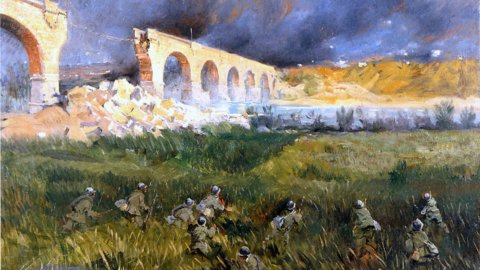In Milan, until 1 July 2018, GAMMANZONI, Study Center for Modern and Contemporary Art (via Manzoni, 45) hosts the exhibition LA GRANDE GUERRA. The pictorial tales of Italico Brass.
The initiative, curated by Enzo Savoia and Francesco Luigi Maspes, is part of the celebrations promoted in Italy for the centenary of the First World War (1915-1918).
THE GREAT WAR. The pictorial tales of Italico Brass presents about thirty paintings by ITALICO BRASS (Gorizia, 1870 – Venice, 1943) who, at the outbreak of the Great War obtained permission from the Supreme Command and the Royal Navy to follow the soldiers along the front line, to make sketches and studies, especially in the area between Sdraussina, Mount San Michele and San Martino del Carso, in the years 1915-1916.
What the writer Mario Rigoni Stern called "the pictorial tales of the Great War" are living images of cyclist bersaglieri, of the entry of cavalry patrols into Aquileia and Palmanova; they are scenes that portray the troops in action, when they advance in the mud or in the trenches under fire at night, when they lead the Austro-Hungarian troops captive in the rain or climb the Alpine passes, weighed down by weapons and rucksacks. They are also subjects of simple daily life in the camp, of soldiers preparing rations, of ammunition depots and views of the militarized cities of Venice, Gorizia and Udine.
However the war painted by Italico Brass never appears so tragic; “Brass's trenches are quiet, you don't smell the smell of death” Mario Rigoni Stern once again recalled.
And this thanks to his pictorial language, mainly lyrical and influenced, after study stays in Munich and Paris, where he met the Impressionists, by the Venetian culture of Ricci, Tiepolo and Guardi.
In his painting, air, light and color blend and spread effectively and indissolubly.
In addition to the paintings by Italico Brass from the family collection, the Brass heirs, the exhibition itinerary is completed with a series of period photographs on the First World War and with a comparative section dedicated to the images of soldiers in action painted by Giulio Aristide Sartorio, Giuseppe Montanari and Achille Beltrame.
The exhibition is accompanied by a GAM Manzoni editions catalog with texts by Mario Rigoni Stern and Alessandra Brass, the artist's niece.
BIOGRAPHICAL NOTES
Italico Brass was born in Gorizia in 1874; the town was Austrian but the family was irredentist and this explains his name. He studied in Munich and Paris alongside the Impressionists. In 1895, returning from France, he moved to Venice. He dedicated himself to the landscape, with long stays in the Belluno area and in Friuli Venezia Giulia and was present at almost all the Biennials, where he also set up two personal exhibitions (1910 and 1935) and had a posthumous personal exhibition in 1948.
He participated in exhibitions in Italy (Turin, Milan, Rome, Trieste…) and abroad (Paris, Vienna, Budapest, Warsaw, Hensilki, Riga…), in which he was repeatedly awarded. Furthermore, his good knowledge of ancient art favored him in the selection of technical commissions for the great exhibitions of Titian (1935), Tintoretto (1937) and Veronese (1939).
After the outbreak of the Second World War, he only obtained permission from the Regia Marina to paint from life, without military subjects, but he died suddenly in Venice in 1943.
THE GREAT WAR. The pictorial tales of Italico Brass.
Milan, GAMMANZONI – Study Center for Modern and Contemporary Art (via A. Manzoni, 45)





